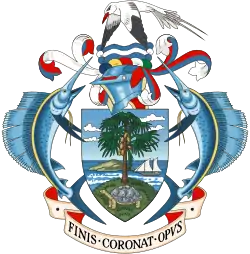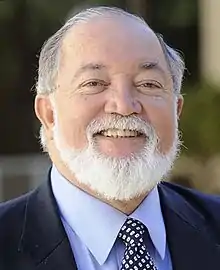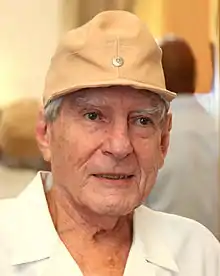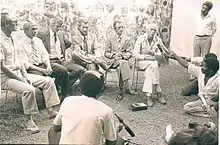Politics of Seychelles
The politics of Seychelles have historical roots in both one-party socialism and autocratic rule. Following independence from the United Kingdom in 1976, Seychelles was a sovereign republic until 1977, when the original President and leader of the Seychelles Democratic Party, James Mancham, was overthrown in a bloodless coup by the Prime Minister France-Albert René. René installed a single-party socialist state under the Seychelles People's Progressive Front which remained in place until 1993, when multiparty elections took place for the first time since independence. Modern day Seychelles governance takes place in a framework of a presidential republic, whereby the President of Seychelles is both head of state and head of government, and of a multi-party system. Executive power is exercised by the government. Legislative power is vested in both the government and the National Assembly.
 |
|---|
| This article is part of a series on the politics and government of Seychelles |
| Constitution |


Political history
Pre-independence political movements
While under British colonization, the people of the Seychelles had little to no say in how they were governed. Following the end of World War I, however, this began to change. The first political movement in the Seychelles was the Planters Association, which came into existence around 1918. In addition to the movement of the Planters Association, workers in the Seychelles petitioned the government about their poor working conditions and tax structure, which led to some proposed reform by the governor at the time, Governor Sir Arthur Grimble. Ultimately though, these reforms did not go into action, as the beginning of World War II put everything on hold.
The Planters Association was primarily focused on the interests of rich, white landowners and not the workers whom they employed. The League of Coloured Peoples formed as a result, and demanded minimum wage laws and health care reform.[1]
The first actual political party, the Taxpayers Association, was not formed until 1939. This Taxpayers Association was also an organization primarily made up of rich white landowners, so its goals were, again, purely the advancement of their personal interests and the interests of the plantocracy.
1948 marked the first year in which Seychelles enjoyed any sort of suffrage, but it was limited only to literate property owners, which made up just 2,000 people in a population of over 36,000. As a result of the first elections in 1948, most representatives on the new Legislative Council were members of either the Planters' or Taxpayers' organizations.[1]
In 1964, the Socialist Seychelles People's United Party (SPUP) was formed. Led by London-educated lawyer France Albert Rene, they campaigned on a platform of autonomy from Britain. Another London-educated lawyer, James Mancham headed the Seychelles Democratic Party (SDP), which was created the same year, and by contrast wanted closer integration with Britain. Early elections between these two parties seemed in part based on the personal rivalry between these two leaders.[2]
As a result of the 1967 elections, the first elections under universal adult suffrage, each party gained three seats in the legislature. Mancham's SDP retained a single-seat lead in the legislature, despite the SPUP having a slight margin of victory in number of votes. This result was met with protests and strikes by supporters of the SPUP throughout the following year. [2]
1970 brought constitutional revisions to the colonial government of Seychelles, instituting a smaller-scale parliamentary system, but leaving plurality voting for the single-member districts.[2] In the following elections in both 1970 and 1974, Mancham gained a small majority in votes, but a large one in seats, through a voting system which relied on the principle of "first past the post". Specifically in the 1974 elections, Mancham's SDP won a disproportionate amount of seats, 13 out of 15, with just barely over half of the vote.[1][2]
Social unrest was rampant during this period, with strikes and protests, as well as bombings in 1972, all attributed to the SPUP. While this was partially attributable to the issues faced with the voting system, tensions regarding independence and rumored political repression and jailing of SPUP activists was also a factor. [2]
In June of 1975, the SDP and SPUP began a coalition government in order to negotiate independence with Britain. The British Government was asked to appoint an electoral review commission so that differences in opinion on legislative makeup and representation could be reconciled. An informal agreement between the two parties was reached, and ten seats were added to the Legislative Assembly, five to be nominated by each party. A cabinet of ministers also was formed consisting of eight members of the DP and four of the SPUP, with Chief Minister Mancham becoming Prime Minister.[2]
Independence
Although Mancham's SDP had initially opposed independence, public opinion on the island heavily favored it, and on June 29, 1976, the British officially granted independence to the Seychelles. Mancham was named the new President, and René became prime minister. The new government kept the original distribution of seats per their 1975 agreement. Each party agreed to a "grand coalition" until 1979, when the next elections would take place. [2][3]
Less than one year after independence, on 5 June 1977, the SPUP overthrew the newly formed government in a bloodless coup while Mancham was overseas at a Commonwealth conference in London.[4] René initially denied involvement, but eventually took responsibility as leader of the SPUP. This coup was claimed to have been to prevent the establishment of a one-party state, but likely was more motivated by the SPUP's lack of representation in the newly-formed legislature. [2] Following the coup, René was installed as President and ruled by proclamation for the next two years, before imposing a new constitution in 1979 without referendum. During this period, the SPUP was formally renamed the Seychelles People's Progressive Front, and became the sole ruling party of the new single-party socialist state. [4] New elections were also called in 1979, and Rene was formally elected President of Seychelles.
One-party socialism
The newly reformed system of one-party socialism featured a directly elected president, as well as the original plurality system of legislative representation. All political activity took place under the rule of the SPFF, and the President was voted for on a yes-no basis by any Seychelles citizen 17 or older. René enjoyed almost unchecked executive power, and appointed his own cabinet as well as his own chair of the Assembly. The legislature itself was unable to rule independently, and instead only enacted the bills proposed by the executive. Criticism of René or any aspect of his government was not tolerated.[5]
Since his regime operated under single-party status, René served as the only presidential candidate for elections in 1979, 1984, and 1989, which he won with over 90% of the vote. [2] René maintained this level of influence and power through systematic torture and widespread human rights violations, as well as state violence against his political enemies throughout his presidency. He admitted to spying on oppositional leaders, and is thought to have been involved in the murder of Gerard Hoareau. His party also maintained control through the National Youth Service, which assisted in indoctrinating and training Seychellois children in traditional curricula and military affairs. René employed a combination of Russian, American, and Tanzanian influence and support to assist him in maintaining power and defending himself against coup attempts, of which there were plenty.[5]

On 25 November 1981 a force of mercenaries, led by "Mad" Mike Hoare, attempted to take over the islands, but were discovered at the airport. They briefly took over the tower, but hijacked an Air India flight and fled to South Africa where they were arrested and charged.
In August 1982, mutineers in the Seychelles Army, maintaining loyalty to Rene but in revolt against alleged conditions in the service, took over the radio station. They were overcome by Tanzanian troops, whose intervention was requested by Rene.
In November 1985, Gérard Hoarau, a prominent exiled opponent of Rene was shot and killed by an unidentified gunman on the doorstep of his London home. Hoareau's supporters claimed the Seychelles Government was responsible for the shooting but this was denied and the murder case never solved.[6]
Despite these attempts, for the most part René ruled throughout this period with underground opposition at home. He used Seychelles' strategic importance to obtain significant help from both superpowers of the period without having to commit himself to either. With a suppressed opposition, he was able to power through much needed social reforms.
In February 1992, Conrad Greslé, a prominent local businessman and democracy activist was arrested and charged with treason for planning to overthrow the Seychelles Government with the help of foreign mercenaries and with alleged CIA involvement. [7] This was the last attempt to overthrow the Seychelles Government by force.
Return to multiparty system
After almost sixteen years of one-party rule, President Rene announced a return to the multiparty system of government at an Extraordinary Congress of the ruling Seychelles People's Progressive Front (SPPF) on 4 December 1991. On 27 December 1991, the Constitution of Seychelles was amended to allow for the registration of political parties. Among the exiles returning to Seychelles was James Mancham, who returned in April 1992 to revive his party, the Democratic Party (DP). By the end of that month, eight political parties had registered to contest the first stage of the transition process: election to the Constitutional Commission, which took place on 23–26 July 1992.
The Constitutional Commission was made up of twenty two elected members, fourteen from the SPPF and eight from the DP. It commenced work on 27 August 1992 with both President Rene and Mancham calling for national reconciliation and consensus on a new democratic constitution. A consensus text was agreed upon on 7 May 1993 and a referendum to approve it called for 15–18 June. The draft was approved with 73.9% of the electorate in favor of it and 24.1% against.
23–26 July 1993 saw the first multiparty presidential and legislative elections held under the new constitution, as well as a resounding victory for President Rene. Three political groups contested the elections—the SPPF, the DP, and the United Opposition (UO)—a coalition of three smaller political parties, including Parti Seselwa. Two other smaller opposition parties threw in their lot with the DP. All participating parties and international observer groups accepted the results as "free and fair."

Three candidates again contested the 1998 presidential election: Albert Rene (SPPF), James Mancham (DP), and Wavel Ramkalawan. Again, President Rene and his SPPF party enjoyed a landslide victory. The President's vote in the 20–22 March elections jumped to 66.6% from 59.5% in 1993, while the SPPF garnered 61.7% of the total votes cast in the National Assembly election, compared to 56.5% in 1993.
The twenty-first century

Early elections originally set for 2003 were called in August/September 2001. The Government Party SPPF again prevailed, although the main Opposition Party, Seychelles National Party (previously known as the United Opposition Party) headed by Wavel Ramkalawan, made a surprisingly strong showing and collected 46% of the total votes. The DP, headed by Mancham, did not take part in the elections.
In April 2004, Rene retired as President, passing the office to his Vice President, James Michel. At the next presidential election in July 2006, Michel polled 53.7% of valid votes, Wavel Ramkalawan 45.7% and Phillip Boulle 0.6%. In the May 2007 National Assembly elections, Seychelles People's Progressive Front took 56.2% of votes and Seychelles National Party in coalition with Seychelles Democratic Party took 43.8%. This gave SPPF 18 directly elected seats plus 5 nominated, total 23 seats with the SNP/DP coalition taking 7 directly elected plus 4 nominated, total 11 seats. The former vice-president, Danny Faure, was sworn in as president in October 2016, following the surprise resignation of James Michel.[8]
The new National Assembly building on Ile du Port, Victoria opened in 2009. The building was partly financed by the Government of China.[9][10]
Wavel Ramkalawan is the current President of Seychelles, and was elected in October 2020. Anglican priest Wavel Ramkalawan defeated President Danny Faure by 54.9% to 43.5%. The opposition took power in the Seychelles for the first time since 1977, following its victory in the presidential election.[11]
The election of the National Assembly was held on the 22-24 October 2020. The Seychelles National Party, the Seychelles Party for Social Justice and Democracy and the Seychelles United Party formed a coalition, Linyon Demokratik Seselwa (LDS). LDS won 25 and former ruling party United Seychelles (US) 10 seats of the 35 seats of the National Assembly.[12]
Executive branch
| Office | Name | Party | Since |
|---|---|---|---|
| President | Wavel Ramkalawan | LDS | 26 October 2020 |
The President of Seychelles, who is both head of state and head of government, is elected by popular vote for a five-year term of office, and can be re-elected only once.
The cabinet is presided over and appointed by the President, subject to the approval of a majority of the legislature.
Legislative branch
The National Assembly/Assemblée Nationale has 34 members, elected for a term of five years, 25 members elected in single-seat constituencies and 9 members elected by proportional representation.
Political parties and elections
Presidential elections
| Candidate | Running mate | Party | Votes | % | |
|---|---|---|---|---|---|
| Wavel Ramkalawan | Ahmed Afif | Linyon Demokratik Seselwa | 35,562 | 54.91 | |
| Danny Faure | Maurice Loustau-Lalanne | United Seychelles | 28,178 | 43.51 | |
| Alain St Ange | Peter Sinon | One Seychelles | 1,021 | 1.58 | |
| Total | 64,761 | 100.00 | |||
| Valid votes | 64,761 | 98.10 | |||
| Invalid/blank votes | 1,256 | 1.90 | |||
| Total votes | 66,017 | 100.00 | |||
| Registered voters/turnout | 74,634 | 88.45 | |||
| Source: ECS | |||||
Parliamentary elections
| Party | Votes | % | +/– | Seats | ||||
|---|---|---|---|---|---|---|---|---|
| FPTP | PR | Total | +/– | |||||
| Linyon Demokratik Seselwa | 35,202 | 54.84 | +5.25 | 20 | 5 | 25 | +6 | |
| United Seychelles | 27,185 | 42.35 | –6.87 | 6 | 4 | 10 | –4 | |
| One Seychelles | 1,420 | 2.21 | New | 0 | 0 | 0 | New | |
| Seychellois Alliance | 70 | 0.11 | New | 0 | 0 | 0 | New | |
| Independents | 317 | 0.49 | +0.28 | 0 | 0 | 0 | 0 | |
| Invalid/blank votes | 1,784 | – | – | – | – | – | – | |
| Total | 65,978 | 100 | – | 26 | 9 | 35 | +2 | |
| Registered voters/turnout | 74,634 | 88.40 | – | – | – | – | – | |
| Source: ECS | ||||||||
Results by constituency
| electoral area | LDS | US | One Seychelles | others | tot.valid | tot. turnout | tot. registered | ||||||
|---|---|---|---|---|---|---|---|---|---|---|---|---|---|
| 1 | Anse Aux Pins | 1496 | 52,8% | 1254 | 44,2% | 84 | 3,0% | 2834 | 2916 | 88% | 3304 | ||
| 2 | Anse Boileau | 1564 | 53,1% | 1340 | 45,5% | 41 | 1,4% | 2945 | 3012 | 89% | 3398 | ||
| 3 | Anse Etoile | 2161 | 62,0% | 1273 | 36,5% | 50 | 1,4% | 3484 | 3585 | 88% | 4064 | ||
| 4 | Anse Royale | 1343 | 46,4% | 1484 | 51,3% | 66 | 2,3% | 2893 | 2893 | 86% | 3375 | ||
| 5 | Au Cap | 1845 | 61,7% | 1081 | 36,2% | 41 | 1,4% | 23 | 0,8% | 2990 | 3071 | 88% | 3509 |
| 6 | Baie Lazare | 1324 | 55,0% | 1083 | 45,0% | 2407 | 2481 | 90% | 2756 | ||||
| 7 | Baie Ste Anne | 1289 | 43,5% | 1383 | 46,7% | 292 | 9,9% | 2964 | 3051 | 89% | 3444 | ||
| 8 | Beau Vallon | 1727 | 60,0% | 913 | 31,7% | 239 | 8,3% | 2879 | 2963 | 87% | 3421 | ||
| 9 | Bel Air | 1025 | 51,7% | 870 | 43,9% | 87 | 4,4% | 1982 | 2028 | 88% | 2315 | ||
| 10 | Belombre | 1726 | 63,2% | 1005 | 36,8% | 2731 | 2822 | 87% | 3261 | ||||
| 11 | Cascade | 1317 | 54,2% | 1084 | 44,6% | 27 | 1,1% | 2428 | 2495 | 90% | 2785 | ||
| 12 | English River | 1429 | 57,5% | 980 | 39,5% | 50 | 2,0% | 25 | 1,0% | 2484 | 2575 | 89% | 2908 |
| 13 | Glacis | 1713 | 62,2% | 985 | 35,8% | 55 | 2,0% | 2753 | 2826 | 86% | 3270 | ||
| 14 | Grand Anse (Mahe) | 1428 | 67,6% | 685 | 32,4% | 2113 | 2183 | 88% | 2478 | ||||
| 15 | Grand Anse (Praslin) | 1296 | 51,8% | 1103 | 44,0% | 105 | 4,2% | 2504 | 2521 | 90% | 2810 | ||
| 16 | Ile Perseverance | 1438 | 53,2% | 1098 | 40,6% | 167 | 6,2% | 2703 | 2826 | 92% | 3083 | ||
| 17 | Inner Islands | 665 | 37,1% | 1105 | 61,7% | 22 | 1,2% | 1792 | 1838 | 90% | 2046 | ||
| 18 | Les Mamelles | 1177 | 58,1% | 827 | 40,8% | 22 | 1,1% | 2026 | 2084 | 90% | 2326 | ||
| 19 | Mont Buxton | 1449 | 58,5% | 993 | 40,1% | 35 | 1,4% | 2477 | 2552 | 89% | 2882 | ||
| 20 | Mont Fleuri | 1317 | 58,9% | 919 | 41,1% | 0,0% | 2236 | 2305 | 87% | 2643 | |||
| 21 | Plaisance | 1452 | 53,2% | 1221 | 44,8% | 55 | 2,0% | 2728 | 2845 | 87% | 3257 | ||
| 22 | Pointe Larue | 966 | 46,2% | 1096 | 52,4% | 28 | 1,3% | 2090 | 2142 | 89% | 2400 | ||
| 23 | Port Glaud | 870 | 48,4% | 929 | 51,6% | 1799 | 1856 | 92% | 2008 | ||||
| 24 | Roche Caiman | 776 | 44,4% | 781 | 44,7% | 192 | 11,0% | 1749 | 1803 | 91% | 1990 | ||
| 25 | Saint Louis | 1281 | 59,9% | 781 | 36,5% | 78 | 3,6% | 2140 | 2187 | 85% | 2572 | ||
| 26 | Takamaka | 1128 | 54,7% | 912 | 44,2% | 23 | 1,1% | 2063 | 2118 | 91% | 2329 | ||
| Total | 35202 | 54,8% | 27185 | 42,3% | 1420 | 2,2% | 387 | 0,6% | 64194 | 65978 | 88% | 74634 | |
| source: [13] |
Administrative divisions
Seychelles is divided in 25 administrative districts; Anse aux Pins, Anse Boileau, Anse Etoile, Anse Royale, Au Cap, Baie Lazare, Baie Sainte Anne, Beau Vallon, Bel Air, Bel Ombre, Cascade, English River, Glacis, Grand' Anse (on Mahe), Grand' Anse (on Praslin), Inner Islands, Les mamelles, Mont Buxton, Mont Fleuri, Plaisance, Pointe Larue, Port Glaud, Roche Caiman, Saint Louis, Takamaka
International organization participation
Agence de Coopération Culturelle et Technique, ACP, AfDB, African Union, Commonwealth of Nations, ECA, FAO, Group of 77, IBRD, ICAO, International Red Cross and Red Crescent Movement, IFAD, International Finance Corporation, IFRCS, International Labour Organization, International Monetary Fund, International Maritime Organization, InOC, Intelsat (nonsignatory user), Interpol, IOC, International Organization for Standardization (correspondent), International Trade Union Confederation, Non-Aligned Movement, OPCW, Port Management Association of Eastern and Southern Africa (PMAESA), Southern African Development Community, UN, UNCTAD, UNESCO, United Nations Industrial Development Organization, UPU, World Health Organization, WMO, WToO, WTrO (applicant)
References
- Insight Guides Staff. (2019). Mauritius, Réunion and Seychelles - Insight Guides. APA Publications Services. ISBN 978-1-78919-057-1. OCLC 1103489285.
- Poupko, Eliezer S. (2017-06-25). "An exploratory study of constitutional design in three island states: Seychelles, Comoros, and Mauritius". Journal of Contemporary African Studies. 35 (3): 324–348. doi:10.1080/02589001.2017.1341624. ISSN 0258-9001.
- Scarr, Deryck. "Seychelles: Independence, Revolution, Restoration of Democracy: 1960 to Present." Encyclopedia of African History, edited by Kevin Shillington, Routledge, 1st edition, 2004. Credo Reference,
- "Seychelles." The Hutchinson Unabridged Encyclopedia with Atlas and Weather Guide, edited by Helicon, 2018. Credo Reference, https://search.credoreference.com/content/topic/seychelles. Accessed 04 Dec. 2019.
- Baker, Bruce, 1946- (2008). Seychelles: democratizing in the shadows of the past. OCLC 775526141.CS1 maint: multiple names: authors list (link)
- The assasination [sic] of Gerard Hoarau by the Albert Rene government Seychelles History, retrieved 2019-12-13
- "Truth, Reconciliation and National Unity Commission". www.nation.sc (in Bulgarian). Retrieved 2019-12-13.
- http://country.eiu.com/article.aspx?articleid=1854713969&Country=Seychelles&topic=Politics&subtop_3
- "Opening of the New National Assembly Building". YouTube (in French). SBC Seychelles. 4 December 2009.
- "Construction of new National Assembly building begins". National Assembly of Seychelles. 24 March 2008.
- https://www.bbc.com/news/world-africa-54681360
- https://www.eisa.org/wep/sey2020results0.htm
- 2020 National Assembly elections ECS